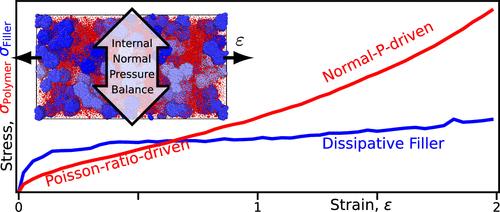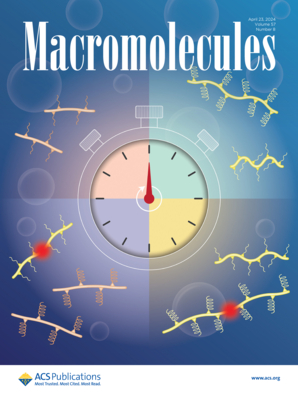Central Role of Filler–Polymer Interplay in Nonlinear Reinforcement of Elastomeric Nanocomposites
IF 5.1
1区 化学
Q1 POLYMER SCIENCE
引用次数: 0
Abstract
Nanoparticles can greatly enhance the mechanical response of elastomeric polymers essential to a wide range of applications, yet their precise molecular mechanisms of high-strain reinforcement remain largely unresolved. In particular, long-standing questions endure over the extent to which glassy bridges or tie chains between particles are needed to facilitate reinforcement. Here we show, based on molecular dynamics simulations, that high-strain reinforcement emerges from an interplay between granular nanoparticulate compressive behavior in the normal direction and polymer incompressibility. This feedback loop, which is initiated by a mismatch in the Poisson ratios of the nanofiller and the polymer, invokes a contribution from the polymer’s bulk modulus to the elongational stress, while the tendency of the polymer to contract in the normal direction maintains a near-jammed filler state. This effect persists even once the direct filler elongational contribution becomes dissipative after the Payne effect yield, as a consequence of enduring filler normal stresses mediated by direct particle–particle contacts. These results indicate that direct particle–particle contact effects, even in the absence of potential augmenting mechanisms such as glassy polymer bridges, can drive the mechanical reinforcement effects typical of experimental systems.

填料-聚合物相互作用在弹性纳米复合材料非线性增强中的核心作用
纳米粒子可以极大地增强弹性聚合物的机械响应,这对广泛的应用至关重要,但其高应变加固的精确分子机制在很大程度上仍未得到解决。特别是,颗粒之间的玻璃桥或连接链在多大程度上需要促进加固,这个问题长期存在。在此,我们根据分子动力学模拟结果表明,高应变加固来自于纳米颗粒在法线方向上的压缩行为与聚合物不可压缩性之间的相互作用。这种反馈回路是由纳米填料和聚合物的泊松比不匹配引起的,聚合物的体模量对拉伸应力有贡献,而聚合物在法线方向的收缩趋势则维持了填料的近堵塞状态。即使在佩恩效应屈服后,直接填料伸长贡献变得耗散,这种效应也会持续存在,这是颗粒-颗粒直接接触介导的持久填料法向应力的结果。这些结果表明,即使没有潜在的增强机制(如玻璃聚合物桥),颗粒与颗粒之间的直接接触效应也能驱动实验系统产生典型的机械增强效应。
本文章由计算机程序翻译,如有差异,请以英文原文为准。
求助全文
约1分钟内获得全文
求助全文
来源期刊

Macromolecules
工程技术-高分子科学
CiteScore
9.30
自引率
16.40%
发文量
942
审稿时长
2 months
期刊介绍:
Macromolecules publishes original, fundamental, and impactful research on all aspects of polymer science. Topics of interest include synthesis (e.g., controlled polymerizations, polymerization catalysis, post polymerization modification, new monomer structures and polymer architectures, and polymerization mechanisms/kinetics analysis); phase behavior, thermodynamics, dynamic, and ordering/disordering phenomena (e.g., self-assembly, gelation, crystallization, solution/melt/solid-state characteristics); structure and properties (e.g., mechanical and rheological properties, surface/interfacial characteristics, electronic and transport properties); new state of the art characterization (e.g., spectroscopy, scattering, microscopy, rheology), simulation (e.g., Monte Carlo, molecular dynamics, multi-scale/coarse-grained modeling), and theoretical methods. Renewable/sustainable polymers, polymer networks, responsive polymers, electro-, magneto- and opto-active macromolecules, inorganic polymers, charge-transporting polymers (ion-containing, semiconducting, and conducting), nanostructured polymers, and polymer composites are also of interest. Typical papers published in Macromolecules showcase important and innovative concepts, experimental methods/observations, and theoretical/computational approaches that demonstrate a fundamental advance in the understanding of polymers.
 求助内容:
求助内容: 应助结果提醒方式:
应助结果提醒方式:


